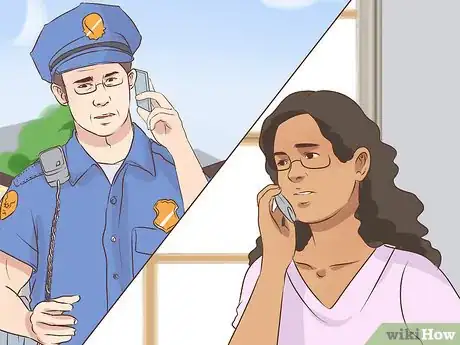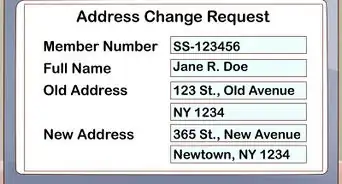This article was co-authored by wikiHow Staff. Our trained team of editors and researchers validate articles for accuracy and comprehensiveness. wikiHow's Content Management Team carefully monitors the work from our editorial staff to ensure that each article is backed by trusted research and meets our high quality standards.
There are 8 references cited in this article, which can be found at the bottom of the page.
This article has been viewed 98,356 times.
Learn more...
If a teenager you love has run away, you are likely terrified, frantic, and unsure of what to do next. Contact law enforcement immediately. After you have spoken with police, you may want to utilize several different strategies to help bring the teenager home, including talking to their friends, using social media to raise awareness, and working with national runaway organizations. Try to remain calm and know that you have friends, family, law enforcement, and national child advocacy agencies supporting you and working to bring your loved one home.
Steps
Contacting Law Enforcement and Missing Children Services
-
1Call the police. If you suspect someone has run away, call 911 immediately. You do not need to wait 24 hours to file a missing person report on a child under eighteen.[1]
- If you are a friend of the runaway, contact the parents first and let them know your suspicions. If you are concerned that your friend ran away from an abusive situation at home, or the parents seem uninterested in locating their child, call the police yourself (or have your parents do it). Runaway teenagers can quickly find themselves in dangerous situations, so it is important you act on your suspicions.
- Give the police a detailed description of the person. Indicate height, weight, hair and eye color, if they have glasses or braces, any distinguishing marks, and the last clothes they were seen wearing, as well as other identifying information.
- For example, you could say, “Jane is sixteen years old. She’s about 5’7” and 130 lbs. She has short brown hair, brown eyes, and a mole next to her right eye. She wears glasses for reading. She likes to dye her hair, so it may also be a bright color. She was last seen wearing a red tank top, black shorts, and black flip flops. She often wears a gold necklace with a cross.”
- Ask the police to make a report to the FBI's National Crime Information Center database, known as NCIC. In order for a missing person poster to be created and disseminated to law enforcement, you need your child’s information entered into this database.[2]
- Ask which officer will be assigned to your child’s case when you are making your initial police report. Record the officer’s information and the best way to contact them.[3]
-
2Call other law enforcement agencies and missing child clearinghouses. After you have filed your initial police report, begin making calls to other organizations that can help you in the search for the runaway. Besides these organizations, your local police may have additional resources for you to contact:
- Call your Sheriff’s Department and state police to report the runaway.
- Call the National Center for Missing and Exploited Children. Call NCMEC at 800-THE-LOST (800-843-5678) after you talk to your local police. They will help coordinate leads to your local police.[4]
- The National Runaway Safeline can provide assistance and support in this situation. Call 800-RUNAWAY (800-786-2929). They can leave your message for your child, should your child get in touch with them. Additionally, they can help your child get in touch with you, and help mediate parent-child disputes if needed.[5]
- When calling other agencies, indicate what you have already done. For example, you could say, “I have already spoken to Officer Jones in my local police department, who took the police report and is assigned to the case. Is there anything else you recommend I do, or anyone else I should talk to?”
Advertisement -
3Write everything down. Keep a notebook handy and record all conversations and phone calls, with dates, times, and topics discussed. This will help jog your memory and keep you organized.[6]
- Things will be moving very quickly, and you will likely not be able to remember details of conversations, or if you talked to a certain person. Get in the habit of writing everything down right away.
Searching for the Runaway
-
1Talk to the runaway’s friends, family, and acquaintances. Make a list of everyone in the person’s life and contact them, starting with their closest connections. Keep track of the names and contact information of those with whom you have spoken. You may want to give a copy of this information to the police as well.
- You could ask, “Manuel, I haven’t seen Caleb since Tuesday. I know you guys are close. Have you seen him? Did he tell you where he was going? Have you been in touch with him?”
- Keep in mind that close friends may try to protect the runaway. They may lie or withhold information.[7]
- Talk to everyone you can think of, including the person’s teachers, coworkers, teammates, or even employees at places where the person liked to hang out. They may have seen or overheard something that may be helpful to you.
- There may be a lot of people to talk to in a short period of time, so enlist trustworthy members of your support network to help you contact people. Consider asking your good friends or reliable family members for help.
-
2Look for clues to their whereabouts. Search the teenager’s room, phone, or computer for clues as to where they might have gone, or people they are with. The police might want to conduct an investigation on your teenager’s property themselves, so make sure to clarify with law enforcement if this is okay for you to do.[8]
- Access their social media accounts and email for hints as to where they have gone.
- Check their phone log and text messages. Follow up with anyone your teenager has communicated with recently.
- Search their room. Look through diaries and notebooks for any useful information.
- Check in with your child’s school. Talk to your child’s teachers and administrators and let them know the situation. Ask to be contacted if they hear of any leads. Ask to access your child’s locker and look through it for any useful information.[9]
-
3Be proactive. While most runaways return home, it is still important to work on bringing the person home safely as quickly as possible. Teenagers frequently run away without a plan,[10] and when food, money, or shelter runs out, could possibly engage in survival sex (trading sex in exchange for necessities) in order to provide for themselves.
- Do not view the runaway situation as something for the runaway to deal with: “She’ll come back when she’s ready, but in the meantime, she needs to deal with the consequences of her behavior.” Teenagers can quickly find themselves in unsafe situations they are incapable of handling, like drug abuse or prostitution.[11]
- Runaway youth are also at an increased risk for homelessness, physical abuse, and mental health issues.[12]
-
4Consider the runaway’s motives. Think about why the person might have run away. Ask yourself some questions about their recent behavior and issues they were facing. Consider if anything they were doing or if anyone they were talking to could help you determine where they may have gone.
- Think about any recent problems at home. Was there a fight, a change in family structure, or abusive behavior?
- Think about their social interactions. Did they start hanging out with new people? Did they keep their social life a secret? Were they talking to someone online frequently?
- Think about their past behavior. Has the teenager run away before? What happened the last time they left? What was their motive for leaving then?[13]
Spreading the Word
-
1Go on social media as soon as possible. Create a Facebook page called “Find [Person’s Name].” Social media can be extremely influential in helping spread the news and raise awareness. Share your page with everyone you know, as well as on local community pages.[14]
- Assume the person is able to see what you are posting. Post pictures of them with friends and family, happy memories, or videos of them having fun with loved ones. These show the runaway how much you love and miss them. These posts also personalize the runaway for strangers who might be following their story and help generate more interest in the case.
- Consider going on Twitter and tweeting the story to news media and other influential individuals.
- Create an email address associated with finding the runaway. Send an email from this address to all your friends and family requesting help, with a link to your Facebook page.
-
2Utilize your network. Connect with people who might be useful in getting the information out there. Consider people who interact with the public on a daily basis, and ask them to reach out to their contacts, and/or display flyers for you.
- For example, you may have a pilot, a minister, or a social worker in your contact list. The pilot could hang the flyer in the crew lounges of airports. The minister could bring flyers to the hospital when visiting patients. The social worker could utilize their contacts at local government agencies to help spread the word of the runaway.
-
3Create a missing person flyer. Distribute several recent pictures of the runaway, and create a flyer with their information and last known whereabouts. Use high-quality photos that show the person’s face from different angles so that others get a better sense of what they look like.[15]
- Put the flyer in high-traffic locations, like gas stations, train stations, interstate rest stops, or bus depots.[16]
- Distribute flyers to local hospitals and mental health treatment centers.
- Ask local stores and businesses to hang a flyer in their window or other location visible to customers.
-
4Reach out to the media. Contact local papers, TV stations, and radio stations with information about the missing person and ask them to help you broadcast the information. Ask them to share the information on their websites as well.[17] .
- You could say, “My son has been missing since Monday. We suspect he ran away. Could you please post his picture in your broadcast tonight, as well as put it up on your website?”
- Provide copies of high-quality photographs of the runaway to media representatives, as well as a missing person flyer if you have made one. Provide both digital and hard copies if necessary.
- Consider designating a family member or friend as your go-to media person. Let this person coordinate photos, schedule interviews if necessary, and research contacts at local publications. Working with the media can be very time-consuming and draining.
Community Q&A
-
QuestionWhat age is it to be safe to run away from home?
 Community AnswerIf you are an adult (eighteen), you can leave home without consequence, but anyone can still file a missing person report about you if they are concerned about your whereabouts. If you are eighteen, you do not need to return home, but you still may have police following up on you to ensure your safety. Running away is a last resort and should not be undertaken unless you are in a dire situation.
Community AnswerIf you are an adult (eighteen), you can leave home without consequence, but anyone can still file a missing person report about you if they are concerned about your whereabouts. If you are eighteen, you do not need to return home, but you still may have police following up on you to ensure your safety. Running away is a last resort and should not be undertaken unless you are in a dire situation. -
QuestionHow do you track them down?
 Community AnswerTry to access the person's social media accounts and phone if they left it behind. If the person is on their parents' cell phone plan, the parents do not need a court order to obtain call and text logs to look into their child's account.
Community AnswerTry to access the person's social media accounts and phone if they left it behind. If the person is on their parents' cell phone plan, the parents do not need a court order to obtain call and text logs to look into their child's account.
References
- ↑ http://www.focusas.org/get-help/what-to-do-teen-runaway/
- ↑ http://www.missingkids.com/Runaway
- ↑ http://www.focusas.org/get-help/what-to-do-teen-runaway/
- ↑ http://www.missingkids.com/Runaway
- ↑ https://www.1800runaway.org/parents-guardians/
- ↑ http://hereandnow.legacy.wbur.org/2012/12/03/finding-runaway-child
- ↑ https://www.phoenix.gov/police/investigations/cold-case/missing-persons/finding-runaways
- ↑ https://www.phoenix.gov/police/investigations/cold-case/missing-persons/finding-runaways
- ↑ https://www.phoenix.gov/police/investigations/cold-case/missing-persons/finding-runaways
- ↑ http://www.pollyklaas.org/enews-archive/2013-enews/article-web-pages/the-truth-about-runaways.html
- ↑ http://www.pollyklaas.org/enews-archive/2013-enews/article-web-pages/the-truth-about-runaways.html
- ↑ http://www.ncsl.org/research/human-services/homeless-and-runaway-youth.aspx
- ↑ https://www.1800runaway.org/parents-guardians/
- ↑ http://hereandnow.legacy.wbur.org/2012/12/03/finding-runaway-child
- ↑ https://www.ncjrs.gov/pdffiles1/ojjdp/228735.pdf
- ↑ http://www.focusas.org/get-help/what-to-do-teen-runaway/
- ↑ https://www.ncjrs.gov/pdffiles1/ojjdp/228735.pdf
About This Article
Having a runaway teenager is a terrifying situation, but try to stay calm so you can contact the right people to help bring your teen home. As soon as you suspect your teen has run away, call emergency services. You don’t need to wait 24 hours to file a missing person report for a child under eighteen. Ask the police to make a report to the FBI’s National Crime Information Center database, which will make and distribute posters of the missing teen. After you call the local police, contact other organizations that can help, like The National Runaway Safeline at 1-800-786-2929. To help search for your teen, talk to their friends and look for clues to their whereabouts, like a diary or email account. To learn how to use social media to find your missing teen, keep reading!







































































